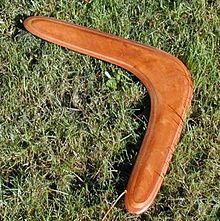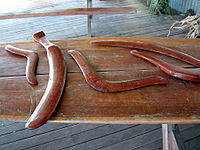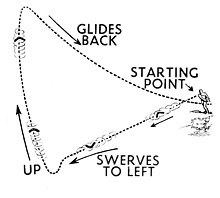Boomerang

A boomerang is a simple wooden implement used for various purposes. It is primarily associated with Australian Aborigines, but other forms are found amongst peoples of North East Africa, Arizona and southern California Native Americans and in India. The oldest boomerang found so far was discovered in a cave in the Carpathian Mountains in Poland and is believed to be about 20,000 years old.[1] Boomerangs come in many shapes and sizes depending on their geographic/tribal origins and intended function. The most recognizable type is the returning boomerang, a kind of throwing stick that, when thrown correctly, travels in a curved path and returns to its point of origin. Other types of boomerang are of the non-returning sort, and indeed, some are not thrown at all but are used in hand-to-hand combat by Aboriginal people.[2] Boomerangs can be variously used as hunting weapons, percussive musical instruments, battle clubs, fire-starters, decoys for hunting waterfowl, and as recreational play toys. The smallest boomerang may be less than 10 cm from tip-to-tip, and the largest over 2 meters in length. Tribal boomerangs may be incised and/or painted with designs meaningful to its maker. Most boomerangs seen today are of the tourist or competition sort, and are almost invariably of the returning type.
History

Boomerang-like devices, including hunting sticks, have been used all over the world for hunting, religious and recreational activities. Their origin is still not fully clear. Research has shown that ancient tribes in Europe used special throwing axes[citation needed]. Also, in ancient Egypt a special type of stick was exclusively used by the pharaohs for hunting birds[citation needed]. However, the world famous "country of the boomerang" is Australia, where the Australian Aborigines have used both boomerangs and hunting sticks for many thousands of years. The name of the boomerang comes from the Indigenous Australian Turuwal tribe of Aborigines who lived south of Sydney, Australia[citation needed].

Today, boomerangs are most used as sporting items. There are different types of throwing contests: accuracy of return; aussie round; trick catch; maximum time aloft; fast catch; and endurance (See below). The modern sport boomerang (often referred to as a 'boom' or 'rang'), is made of Finnish birch plywood, hardwood, plastic or composite materials and comes in many different shapes and colors. Most sport boomerangs typically weigh less than 100 grams, with MTA boomerangs (boomerangs used for the maximum time aloft event) often under 25 grams.
Hunting
It is believed that the shape and elliptical flight path of the returning boomerang makes it useful for hunting. Noise generated by the movement of the boomerang through the air, and, by a skilled thrower, lightly clipping leaves of a tree whose branches house birds, would help scare the birds towards the thrower. This was used to frighten flocks or groups of birds into nets that were usually strung up between trees or thrown by hidden hunters.[citation needed]
Boomerangs for hunting larger prey, such as kangaroo, were also used[citation needed]. These boomerangs are modified as such to fly in a straight path when thrown horizontally, and are heavy enough to take down a kangaroo on impact to the legs or knees. Someone who edited his article has suggested that these are not true boomerangs.
Design

A returning boomerang is an airfoil. Though it is not a requirement that the boomerang be in its traditional shape, it is usually flat. A falling boomerang starts spinning and most then fall in a spiral. When the boomerang is thrown with high spin, the wings produce lift. Larger boomerangs are used in hunting, thus they drop on the ground after striking the target. Smaller ones are used in sport, and are the only boomerangs that return to the thrower. Because of its rapid spinning, a boomerang flies in a curve rather than a straight line. When thrown correctly, a boomerang returns to its starting point.
Returning boomerangs consist of two or more arms or wings, connected at an angle. Each wing is shaped as an airfoil, air travels faster over one surface of an airfoil than the other, as the air is accelerated due to the curvature, thus creating lift, along what is roughly a plane which intersects the airfoil at a near right angle along the long axis of the wing.
These wings are set so that the lift created by each wing opposes the lift of the other, but at an angle such that the flight pattern is constantly shifted as the forces of lift, drag, speed, rotational inertia etc. 'attempt' to reach equilibrium, see Boomerang engineer.
This is what makes the boomerang 'return gracefully to the thrower, fluttering to a stop in his hand'... when thrown correctly. This is also what makes the boomerang 'rocket straight up into the air before plunging to its shattered doom'... when thrown incorrectly. With the exception of long-distance boomerangs, they should not be thrown sidearm or like a Frisbee, but rather throw with the long axis of the wings rotating in an almost-vertical plane.
Some boomerangs have 'turbulators' - bumps or pits on the top surface that act to make the flight more reliable.[3]
Fast Catch boomerangs usually have three or more symmetrical wings (in the planform view), whereas a Long Distance boomerang is most often shaped similar to a question mark. [4] Maximum Time Aloft boomerangs mostly have one wing considerably longer than the other. This feature, along with carefully executed bends and twists in the wings, help to set up an 'auto-rotation' effect to maximize the boomerang's hover-time in descending from its highest point in the flight.
Basic throwing instructions

- A right-handed boomerang circles towards the left, a left-handed boomerang circles towards the right. Most sport boomerangs are in the range of 2.5 to about 4 ounces. The range on most of these is between 25 - 40 yards (or meters)
- A right or left handed boomerang can be thrown with either hand, but the flight direction will depend upon the boomerang, not the thrower. Throwing a boomerang with the wrong handedness requires a throwing motion that will feel awkward to many throwers. Beginners should thus take care to get a boomerang with the correct handedness.
- Grasp one wing of the boomerang nearly vertically so that the other wing points forward and the flat side is away from you. The other way works also, but this way is usually easier to learn. Holding the tip by just the end between your thumb and one or two fingers, launch the boomerang forward quickly while trying more for spin than for very much force.
- The boomerang should flatten out on its own and arc around, sometimes coming to rest a little in front of the thrower or behind the thrower, but ideally it should hover gently and allow the thrower to catch it as a sort of "boomerang sandwich" between the thrower's hands.
- One should not throw a returning boomerang level like a flying disc. The boomerang will turn in the direction of the top of its airfoils, so if that direction happens to be up rather than to the side it may fly high enough that the landing causes damage to the boomerang or whatever it lands on.The boomerang has to have a smooth texture.
Competitions and records
In international competition, a world cup is held every second year, with teams from Germany and the United States dominating international competition. The individual World Champion title was won in 2000, 2002 and 2004 by Swiss thrower Manuel Schütz. In 2006, Fridolin Frost from Germany won the title, with Manuel Schütz finishing third.
Competition disciplines
Modern boomerang tournaments usually involve some or all of the events listed below [5] In all disciplines the boomerang must travel at least 20 metres from the thrower. Throwing takes place individually. The thrower stands at the centre of concentric rings marked on an open field.
- Aussie Round: considered by many to be the ultimate test of boomeranging skills. The boomerang should ideally cross the 50 metre circle and come right back to the centre. Each thrower has five attempts. Points are awarded for distance, accuracy and the catch.
- Accuracy: points are awarded according to how close the boomerang lands to the centre of the rings. The thrower must not touch the boomerang after it has been thrown. Each thrower has five attempts. In major competitions there are two accuracy disciplines: Accuracy 100 and Accuracy 50
- Endurance: points are awarded for the number of catches achieved in 5 minutes.
- Fast Catch: the time taken to throw and catch the boomerang five times. The winner has the fastest timed catches.
- Trick Catch/Doubling: points are awarded for trick catches behind the back, between the feet, etc. In Doubling the thrower has to throw two boomerangs at the same time and catch them in sequence in a special way.
- Consecutive Catch: points are awarded for the number of catches achieved before the boomerang is dropped. The event is not timed.
- MTA 100 (Maximal Time Aloft, field size: 100 metres): points are awarded for the length of time spent by the boomerang in the air. The field is normally a circle measuring 100 metres. An alternative to this discipline, without the 100 metre restriction is called MTA unlimited.
- Long Distance: the boomerang is thrown from the middle point of a 40 metre baseline. The furthest distance travelled by the boomerang away from the baseline is measured. On returning the boomerang must cross the baseline again but does not have to be caught.
- Juggling: as with Consecutive Catch, only with two boomerangs. At any given time one boomerang must be in the air.
There are many other boomerang disciplines, many played just for fun, but most of these are not considered official competition events.
World records
(June 2007)
| Discipline | Result | Name | Year | Tournament |
|---|---|---|---|---|
| Accuracy 100 | 97 points | H.G. Hoffmann / Tom Szartowicz (D) | 2005 | Lausanne (CH) |
| Accuracy 50 | 68 points | Thomas Stehrenberger (CH) | 2001 | Lausanne (CH) |
| Aussie Round | 96 points | Fridolin Frost (D) / John Flynn (USA) / Michael Siems (D) / Tim Lendrum (AUS) | 2005 | Lausanne (CH) / Delaware (USA) / Viareggio 2006 (I) / Sydney 2007 (AUS) |
| Endurance | 81 catches | Manuel Schütz (CH) | 2005 | Milano (I) |
| Fast Catch | 14.60 s | Christian Ruhf (USA) | 1996 | Emmaus (USA) |
| Trick Catch/Doubling | 390 points | Manuel Schütz (CH) | 2004 | Milano (I) |
| Consecutive Catch | 1297 catches | Manuel Schütz (CH) | 2005 | Aalen (D) |
| MTA 100 | 104.87 s | Eric Darnell (USA) | 1997 | Portland (USA) |
| MTA unlimited | 190.2 s | Arnaud Tribillon (F) | 2005 | Dijon (F) |
| Long Distance | 238 m | Manuel Schütz (CH) | 1999 | Kloten (CH) |
Non-discipline record: Smallest Boomerang: Sadir Kattan of Australia in 1997 with 48 mm [1.8 in] long and 45 mm [1.77 in] wide. This tiny boomerang flew the required 20 metres, returning to the accuracy circles on 22 March 1997 at the Australian National Championships. [2]
Related terms
A Kylie is one of the Aboriginal words for the hunting stick used in warfare and for hunting animals[citation needed]. Instead of following a curved flight path, it flies in a straight line from the thrower. They are typically much larger than boomerangs. It can travel very long distances, and due to its size and hook shape can cripple or kill an animal or human opponent. The word is perhaps an English corruption of a word meaning boomerang taken from one of the Western Desert languages, for example, the Warlpiri word karli.
See also
References
- ^ Culturequest article about Boomerags
- ^ Battle Boomerangs
- ^ 'My boomerang'
- ^ 'baggressive.com'
- ^ Based on original text from German wiki.[1]
External links
- International Federation of Boomerang Associations (IFBA)
- Boomerang Association of Australia (BAA)
- Canadian Boomerang Throwers Association (Canboom)
- United States Boomerang Association: Information, Events and more (USBA)
- Danish Boomerang Club
- History of Boomerangs
- Boomerang History
- Unspinning the Boomerang, The Maths and Physics of a Boomerang
- Boomerang aerodynamics, An online dissertation.
- Illustrated How to guide for crafting a boomerang
- Explanation where the word Boomerang may come from
- Boomerang Competition Events
- Boomerang Passion, a French boomerang portal (in English)
- How to Throw Boomerangs, a beginner's to advanced guide to throwing boomerangs.
